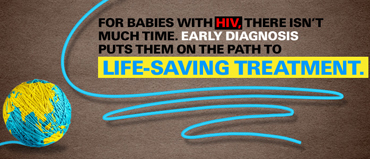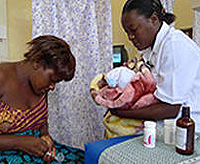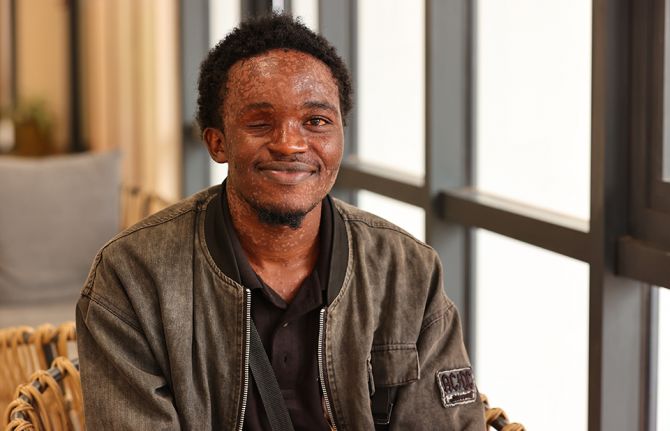
Feature Story
Early diagnosis and treatment save babies from AIDS-related death
27 May 2009
27 May 2009 27 May 2009A version of this story first appeared at unicef.org

‘Loud and Clear’, the Unite for Children, Unite against AIDS video, shows how early infant diagnosis of HIV can save lives
Many infants across the world are dying needlessly because they are not being tested early enough for HIV and treated if they have the virus. Without treatment, half of all HIV-positive babies will not live long enough to see their second birthday; a third will not see their first.
To help address this situation, the Unite for Children, Unite against AIDS campaign has launched a new video vividly highlighting the importance of early testing and treatment to save the lives of infants who have HIV.
As the video, known as ‘Loud and Clear’, shows infants who are diagnosed and treated early have a far higher chance of survival than those who go untested and untreated. Research demonstrates that if newborns are tested at the age of six weeks and on treatment by 12 weeks there can be a dramatic 75% reduction in infant mortality due to AIDS.
However, according to a report published last year by UNICEF, UNAIDS and WHO, in 2007 only 8% of children born to HIV-positive mothers were tested before they were two months old. Mothers can also help prevent HIV transmission – and protect their own health – by being tested and treated themselves during pregnancy.
Access to care and treatment
Since the launch of the Unite for Children, Unite against AIDS global campaign in 2005, there has been significant progress in scaling up prevention of mother-to-child transmission of HIV – and in the provision of paediatric treatment for babies born with the virus.
In 2007, a third of HIV-positive pregnant women received antiretroviral drugs, or ARVs, to prevent transmission to their children, compared with only 10 per cent in 2004.
Still, far too few pregnant women in the developing world know their HIV status, and too few are tested and treated: both are essential for mother and child. However, most pregnant women who have been diagnosed with HIV do not have access to essential care and treatment, including ARV therapy.
“Mothers should be able to access the tests and drugs necessary to ensure they can protect their babies and themselves,” said UNICEF Senior Advisor on HIV and AIDS, Dr Doreen Mulenga. “Antiretroviral drugs can substantially reduce the risk of a baby getting the HIV virus from his mother.”
Children at risk
Children bear a heavy burden of the virus. UNAIDS and WHO estimates show that in 2007 alone some 370,000 young people under the age of 15 were newly infected, that’s around 1,000 a day; and 270,000 died, the majority under the age of 5. In the same year, fewer than 200,000 young people living with HIV received antiretroviral treatment. Further, those on ARVs often receive it too late for optimal benefits to be gained: recent studies report that the median age at which children begin such treatment is between five and nine years old.
Great strides in Zambia
In Lusaka, the capital of Zambia, the Chelstone Clinic provides vital programmes to treat pregnant women living with HIV and to prevent mother-to-child transmission. The country has made great strides in expanding such programmes, which include HIV testing during pregnancy, ARV regimens for HIV-positive pregnant women, prophylactic antibiotics and ARVs for infants exposed to HIV in utero, and early infant diagnosis and treatment.

Maureen Sakala, who was diagnosed with HIV while pregnant, practices preparing prophylactic antiretroviral medicine for her newborn son, Christopher, held by midwife Grace Kayumba at the Chelstone Clinic in Lusaka, Zambia.
Credit: UNICEF/NYHQ2009-0307/Nesbitt
Christopher was recently born at the clinic. His mother, Maureen Sakala, lives with her mother, siblings and 12 orphaned children – including the children of her brother, who died of AIDS-related illness.
Ms Sakala learned that she was HIV-positive during an antenatal check-up. She participates in the prevention programme at the clinic, where she learned to administer ARVs to Christopher for the first seven days after his birth as a prophylactic measure against HIV infection. His chances of survival are much improved because of Zambia’s success in strengthening maternal, newborn and child health services.
Preventing mothers from dying and babies from becoming infected with HIV has been identified as one of the eight priority areas UNAIDS and its Cosponsors will focus on for the period 2009–2011 under the Joint action for results: UNAIDS outcome framework, 2009 – 2011.
By providing greater access to HIV testing and treatment, partners around the world are working to protect babies like Christopher, and their mothers, from the devastating impact of AIDS.
Early diagnosis and treatment save babies from AI
Cosponsors:
Partners:
Unite for Children, Unite against AIDS
Feature stories:
Early infant HIV diagnosis helps save lives in Malawi (01 December 2008)
UNICEF: Communities provide a bigger ‘family’ for orphaned children in Rwanda (09 March 2009)
Third stocktaking report on children and AIDS (01 December 2008)
Multimedia:
'Loud and Clear' video: How early infant diagnosis of HIV can save lives
Photo essay on paediatric HIV in Zambia
PSA: Claudia Schiffer, UNICEF UK Ambassador on early infant diagnosis
Publications:
Joint action for results: UNAIDS outcome framework, 2009 – 2011 (pdf, 432 Kb.)
Unite for Children, Unite against AIDS Briefing Paper: Scaling up early infant diagnosis and linkages to care and treatment January 2009 (pdf, 923 Kb.)
Children and AIDS: Third stocktaking report, 2008 (pdf, 1.90 Mb.)
Children and AIDS: Third stocktaking report, 2008, Summary (pdf, 2.70 Mb.)



